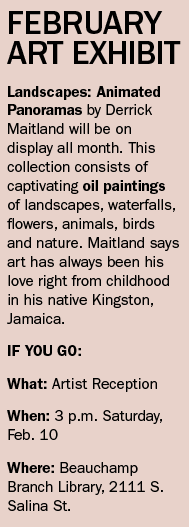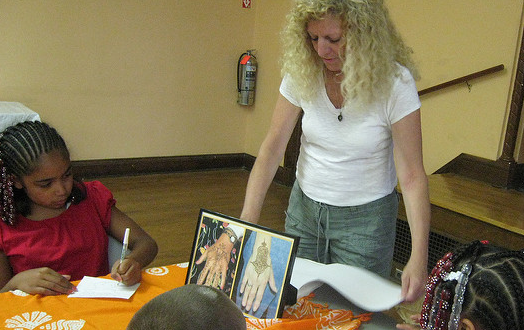Beauchamp library hosts local art exhibitions to inspire creative minds
Ever since philanthropist Andrew Carnegie built more than 2,500 of them a century ago, libraries — especially public libraries — have served as vital community centers, where children can go for help with schoolwork and adults can seek information to find jobs.
Beauchamp Branch Library, a South Side stalwart at 2111 S. Salina St., goes a step further, providing exhibition space for local artists — a vibrant visual counterpoint to the books, papers and personal computer screens available in the main room.
 For the past 10 years, Beauchamp has run regular displays of work by Syracuse artists, giving public exposure to painters and photographers and, perhaps, inspiration to creative-minded patrons who might feel inclined to try their hand at such work themselves.
For the past 10 years, Beauchamp has run regular displays of work by Syracuse artists, giving public exposure to painters and photographers and, perhaps, inspiration to creative-minded patrons who might feel inclined to try their hand at such work themselves.
Paschal Ugoji, a Beauchamp librarian, has run the art exhibit program since he joined the library in 2008. The library, he said, focuses on spreading information and literacy in the community. “People come in and interact and get whatever they want,” Ugoji said. What they want includes space to see art.
This winter, Ugoji invited local painter Suzanne Masters to display her colorful works in Beauchamp’s main room. Ugoji said he has known Masters for several years and thought her acrylic work in eye-catching colors was impressive for a public display.
Masters, a Syracuse University alumna, said she has been an after-school art teacher and also has presented art workshops for children at Beauchamp. “It’s just whatever comes up, wherever there’s a need,” she said, referring to her work with children. “If somebody tells me about it and I can get in there, I’ll do it.”
Masters works in a style called abstract expressionism, in which bold colors and unusual shapes dominate. The Museum of Modern Art in New York, which dates the style to the 1940s, also calls it “action painting.”
Ugoji, taking the role of art critic in a recent interview, described Masters’ work “as visually attractive, very creative.”
Ugoji said artwork at the library is popular, especially when Beauchamp holds receptions to introduce a local artist. “People bring their friends to see what’s on display,” he said.
Emily Duke, associate professor of transmedia studies at Syracuse University, said when the work of local artists is displayed in public spaces such as coffee shops or libraries, the event is often more about community building — “not necessarily about the fame and glamour with the art world.”
Duke said schools should teach art so young people learn how to use it as a kind of “cultural capital,” which they can draw from lifelong.
“I think it’s a great thing to put art in public spaces,” Duke said.
— Article by Katelyn Faubel, The Stand reporter
 The Stand
The Stand


